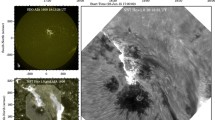Abstract
We generated an event catalog with an automated detection algorithm based on the entire EUVI image database observed with the two Solar Terrestrial Relations Observatory (STEREO)-A and -B spacecraft over the first six years of the mission (2006 – 2012). The event catalog includes the heliographic positions of some 20 000 EUV events, transformed from spacecraft coordinates to Earth-based coordinates, and information on associated GOES flare events (down to the level of GOES A5-class flares). The 304 Å wavelength turns out to be the most efficient channel for flare detection (79 % of all EUVI event detections), while the 171 Å (4 %), 195 Å (10 %), and the 284 Å channel (7 %) retrieve substantially fewer flare events, partially due to the suppressing effect of EUV dimming, and partially due to the lower cadence in the later years of the mission. Due to the Sun-circling orbits of STEREO-A and -B, a large number of flares have been detected on the farside of the Sun, invisible from Earth, or seen as partially occulted events. The statistical size distributions of EUV peak fluxes (with a power-law slope of α P =2.5±0.2) and event durations (with a power-law slope of α T =2.4±0.3) are found to be consistent with the fractal-diffusive self-organized criticality model. The EUVI event catalog is available on-line at secchi.lmsal.com/EUVI/euvi_autodetection/euvi_events.txt and may serve as a comprehensive tool to identify stereoscopically observed flare events for 3D reconstruction and to study occulted flare events.







Similar content being viewed by others
References
Aschwanden, M.J.: 2012, Astron. Astrophys. 539, A2.
Aschwanden, M.J.: 2013, In: Aschwanden, M.J. (ed.) Self-organized Criticality Systems, Open Academic Press, Berlin, 439. Chapter 13. www.openacademicpress.de/ojs2/index.php/socs .
Aschwanden, M.J., Freeland, S.L.: 2012, Astrophys. J. 754, 112.
Aschwanden, M.J., Shimizu, T.: 2013, Astrophys. J. in press.
Aschwanden, M.J., Wülser, J.P., Nitta, N., Lemen, J.: 2009, Solar Phys. 256, 3. ADS: 2009SoPh..256....3A . doi: 10.1007/s11207-009-9347-4 .
Bak, P., Tang, C., Wiesenfeld, K.: 1987, Phys. Rev. Lett. 59, 381.
Dresing, N., Gomez-Herrero, R., Klassen, A., Heber, B., Karthavukh, Y., Dröge, W.: 2012, Solar Phys. 281, 281.
Howard, R.A., Moses, J.D., Vourlidas, A., Newark, J.S., Socker, D.G., Plunkett, S.P., et al.: 2008, Space Sci. Rev. 136, 67.
Hurlburt, N., Cheung, M., Schrijver, C., Chang, L., Freeland, S., Green, S., Heck, C., Jaffey, A., Kobashi, A., Schiff, D., Serafin, J., Seguin, R., Slater, G., Somani, A., Timmons, R.: 2012, Solar Phys. 275, 67. ADS: 2012SoPh..275...67H . doi: 10.1007/s11207-010-9624-2 .
Isobe, T., Feigelson, E.D., Akritas, M.G., Babu, G.J.: 1990, Astrophys. J. 364, 104.
Martens, P.C.H., Attrill, G.D.R., Davey, A.R., Engell, A., Farid, S., Grigis, P.C., Kasper, J., Korreck, K., et al.: 2012, Solar Phys. 275, 79. ADS: 2012SoPh..275...79M . doi: 10.1007/s11207-010-9697-y .
Mewaldt, R.A., Cohen, C.M.S., Mason, G.M., von Rosenvinge, T.T., Leske, R.A., Luhmann, J.G., Odstrcil, D., Vourlidas, A.: 2013, In: Zank, G.P., Borovsky, J., Bruno, R., Cirtain, J., Cranmer, S., Elliott, H., Giacalone, J., Gonzalez, W., Li, G., Marsch, E., Moebius, E., Pogorelov, N., Spann, J., Verkhoglyadova, O. (eds.) Solar Wind 13 CP-1539, 116. doi: 10.1063/1.4811002 .
Nitta, N.V., Aschwanden, M.J., Boerner, P.F., Freeland, S.L., Lemen, J.R., Wülser, J.P.: 2013, Solar Phys. doi: 10.1007/s11207-013-0307-7 .
Rouillard, A.P., Sheeley, N. R Jr., Tylka, A., Vourlidas, A., Ng, C.K., Rakowski, C., Cohen, C.M.S., Mewaldt, R.A., et al.: 2012, Astrophys. J. 752, 44.
Thompson, W.T. 2006, Astron. Astrophys. 449, 791.
Thompson, W.T.: 2010, Astron. Astrophys. 515, A59.
Thompson, W.T., Wei, K.: 2010, Solar Phys. 261, 215.
Veronig, A.M., Muhr, N., Kienreich, I.W., Temmer, M., Vrsnak, B.: 2010, Astrophys. J. Lett. 716, L57.
Watanabe, K., Masuda, S., Segawa, T.: 2012, Solar Phys. 279, 317. ADS: 2012SoPh..279..317W . doi: 10.1007/s11207-012-9983-y .
Wülser, J.P., Lemen, J.R., Tarbell, T.D., Wolfson, C.J., Cannon, J.C., Carpenter, B., et al.: 2004, Proc. SPIE 5171, 111.
Acknowledgements
We thank Frédéric Auchère, Lindsay Glesener, Nat Gopalswamy, Bala Poduval, Andreas Klassen, and David Long for helpful discussions and suggestions to create a mission-long STEREO/EUVI event catalog. Part of the work was supported by the NASA STEREO mission under NRL contract N00173-02-C-2035. The STEREO/SECCHI data used here were produced by an international consortium of the Naval Research Laboratory (USA), Lockheed Martin Solar and Astrophysics Lab (USA), NASA Goddard Space Flight Center (USA), Rutherford Appleton Laboratory (UK), University of Birmingham (UK), Max-Planck-Institut for Solar System Research (Germany), Centre Spatiale de Liège (Belgium), Institut d’Optique Théorique et Appliquée (France), and Institut d’Astrophysique Spatiale (France). The USA institutions were funded by NASA, the UK institutions by the Science & Technology Facility Council (which used to be the Particle Physics and Astronomy Research Council, PPARC), the German institutions by Deutsches Zentrum für Luftund Raumfahrt e.V. (DLR), the Belgian institutions by Belgian Science Policy Office, and the French institutions by Centre National d’Etudes Spatiales (CNES) and the Centre National de la Recherche Scientifique (CNRS). The NRL effort was also supported by the USAF Space Test Program and the Office of Naval Research.
Author information
Authors and Affiliations
Corresponding author
Rights and permissions
About this article
Cite this article
Aschwanden, M.J., Wülser, JP., Nitta, N.V. et al. STEREO/Extreme Ultraviolet Imager (EUVI) Event Catalog 2006 – 2012. Sol Phys 289, 919–938 (2014). https://doi.org/10.1007/s11207-013-0378-5
Received:
Accepted:
Published:
Issue Date:
DOI: https://doi.org/10.1007/s11207-013-0378-5




